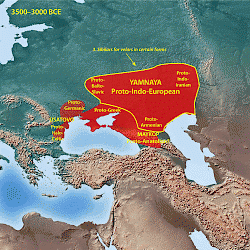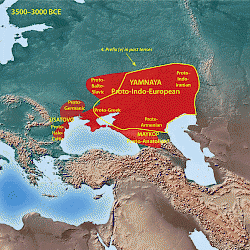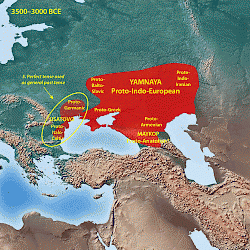Indo-Europeans
Q475027Indo-Europeans: general name for the people speaking an Indo-European language. They are (linguistic) descendants of the people of the Yamnaya culture (c.3600-2300 BCE) in Ukraine and southern Russia, and settled in the area from Western Europe to India in various migrations in the third, second, and early first millenniums BCE.
The Problem
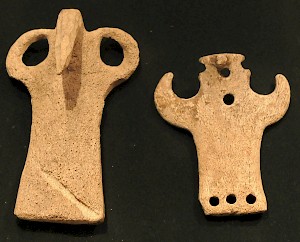
It has always been known that many languages in Europe are related. Italian, Spanish, Romanian, French, and Portuguese are descendants of ancient Latin. English, Dutch, Frisian, German, and the Scandinavian languages go back to the dialects of the ancient Germans. The old languages of Ireland, Wales, Cornwall, and the isle of Man share a common ancestor in ancient Celtic. In the late eighteenth century, European scholars started to understand that these language families were not just related to each other, but to the ancient Persian and Indian languages as well. The existence of this “Indo-European language family” came as a surprise. How to explain this?
Nineteenth-century experience offered several possibilities. Migration was a common practice in the age of imperialism and could explain why languages in various regions could be similar. Alternatively, people might adopt first individual words and later complete languages from their neighbors. The nineteenth-century scholars usually opted for the first explanation: long time ago, there had been one Indo-European nation that had, with a series of migrations, moved to western Europe and the Far East. But who were these people?
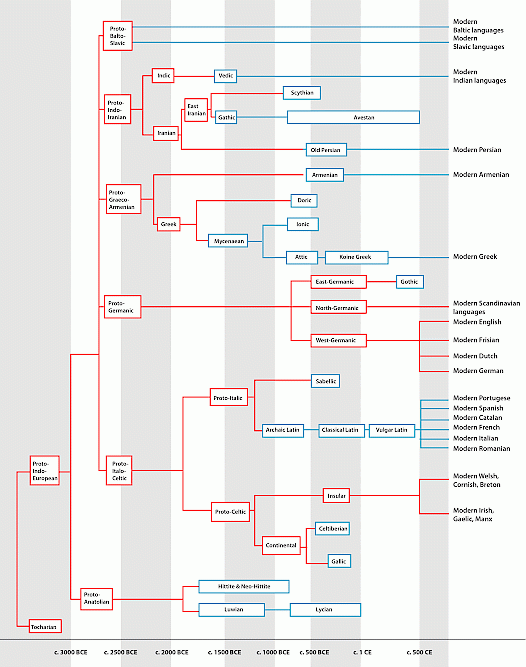
Looking for a Homeland
The first thing scholars needed to find out, was the nature of the original homeland. They did so by looking at the shared vocabulary of the Indo-European languages. Those languages had similar words for the same trees and animals, allowing scholars to say something about the homelands’ flora and fauna. There must have been bears, otters, vultures, cranes, salmons, beavers, oaks, junipers, apples. Most of these are of course quite ubiquitous, but the presence of otters and beavers suggested forests and extensive wetlands, which ruled out large parts of Eurasia. Words like “king”, “wagon”, and “plow” were also interesting, because archaeologists could find elite burials, chariots, and agricultural tools.
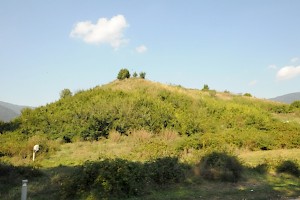
The quest for the original homeland has had several false starts, but the steady accumulation of data on the one hand (e.g., the discovery of the Hittite, Luwian, and Tocharian languages in the twentieth century) and the growth of our understanding of the ways languages evolve on the other hand, have helped to falsify certain hypotheses. For example, linguists have discovered that languages cannot evolve very rapidly or extremely slowly, which has helped to rule out theories that presupposed unusually swift or slow language change.
In the late twentieth century, the "kurgan hypothesis" gained ground: the first speakers of Indo-European languages belonged to the Yamnaya culture, pastoral agriculturalists who buried their leaders in funeral mounds (kurgans, in Russian) and had domesticated the horse, which allowed long-distance travel.
The First Migrations

The Yamnaya culture (also known as Pit Grave culture) flourished between c.3600 and 2300 BCE in Ukraine and southern Russia. Some of the Yamnaya people were farmers and cultivated the land, and others were nomads who roamed across the steppe with their flocks. Before c.3500 BCE, two groups branched off from the Yamnaya people. The first of these moved to the east, probably as shepherds looking for new fields in Siberia, and settled in the west of what is now China.
Archaeologists call these people the Afanasievo culture. These eastern settlers would continue to live there for centuries. Later, they would convert to Buddhism, and because we know the central concepts of this religion, the Buddhist texts written in western China can be understood. Their languages, which are closely related to the oldest Indo-European language, are called Tocharian A and Tocharian B.

The second group moved to the south, to the area of the Caucasus Mountains, where they must have lived for quite some time before they proceeded to Anatolia. Perhaps they were identical to the Maykop Culture. They shared words for yoke and thill with the Indo-Europeans (proving that they had left after the Yamnaya culture had learned agriculture), but did not share the words to describe wagons, wheels, naves, axles, and so on. This proves that they left before the invention of the wheel and the wagon, which in turn proves that they branched off before c.3500 BCE.
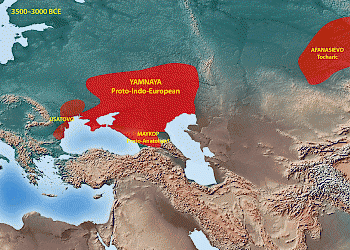
The arrival of this second group in Anatolia is documented in cuneiform texts found at Kültepe (ancient Kaneš), which refer to several wars. It is likely that at some stage, Kaneš itself was taken over. The descendants of these immigrants spoke Palaic, Hittite, and two Luwian languages, which can be documented in the Bronze Age. In the Iron Age, we find late forms of Luwian in Lydia (western Turkey), Lycia, and Caria (both in southwestern Turkey).
These languages have retained an element of the Proto-Indo-European language: passive voice endings with /r/. In the homeland, this characteristic was lost. It can also be found in a third group to move away at a very early stage, Proto-Italo-Celtic (below). The speakers of this language can probably be identified with the people of the Usatovo culture. (All identifications in this article are, of course, very tentative, if only because there is no one-on-one match between language and archaeological culture.)
Increased Mobility
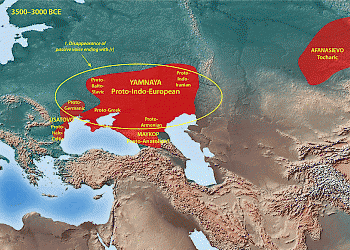
As indicated above, the Yamnaya people had learned to domesticate horses and knew how to build wagons (for transport, with solid wheels). Chariots for warfare, with spoked wheels, were a later invention. Horses and wagons gave the Yamnaya people a possibility to travel longer distances than before. This mobility had two faces: often, they were just shepherds looking for fields, but they could be aggressive too.
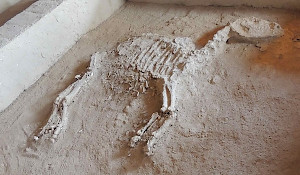
So, after about 3500 BC, the Yamnaya region started to expand. As a consequence, linguistic changes no longer reached everyone. The Proto-Italo-Celtic group had already moved to the western periphery when the passive voice endings with /r/ disappeared from the other languages (indicated in yellow on the picture below; and see map 3).
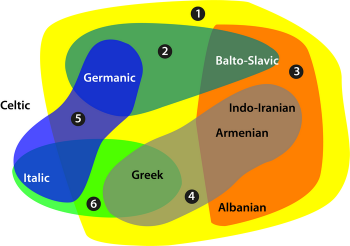
Other changes that may be dated to the period between, say, 3500 and 3000 BCE, which did not reach all speakers of the Indo-European dialects:
- In the Proto-Germanic and Proto-Balto-Slavic group, probably located in the west and northwest, case endings on /bh/ were replaced by /m/ (indicated in greenish/blueish on the picture and on map 4).
- In the eastern part of the Yamnaya region, the /k/ became an /s/ (indicated in orange and map 5). This shift is called the difference between kentum- and satem-languages.
- It seems that people who were living along the northern shores of the Black and Caspian Seas (the ancestors of the Greeks, Armenians, and Indo-Iranians), introduced an augment /e-/ to indicate the past tense (map 6 and indicated in grey).
- In Proto-Germanic and Proto-Italic, the perfect tense can be used as a general past tense (map 7 and blue).
All these linguistic shifts can be reconstructed from later languages and because they had to take place among neighboring languages, we have an idea of the relative positions of the proto-languages in the Yamnaya region.
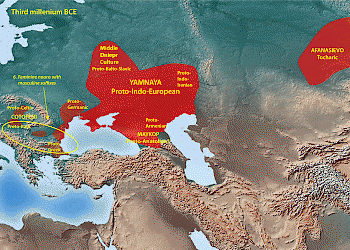
Finally, a shift that must have occured after the four shifts mentioned above, and only among the people living in southeastern Europe: the introduction of feminine nouns with masculine suffixes (in Proto-Italic and Proto-Greek) (green and map 8). Gradually, the one Indo-European language, in a gradually expanding area, was falling apart. By the end of the Yamnaya period, in c.2300 BCE, people from the western end of the region must have been almost incomprehensible for people from the eastern end.
To the Balkans

At that moment, the Indo-Europeans had already moved far away from their homeland in Ukraine and southern Russia. Following the western shore of the Black Sea, one group reached the Lower Danube. Here, the speakers of the Indo-European languages are called the Usatovo culture.
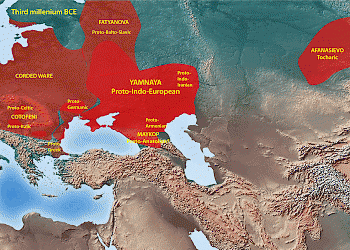
One of the most interesting artistic objects associated with this migration is a kind stone stele, representing a man or a woman. These monuments have been found along the roads to the places where copper could be obtained. The art of making these monuments was taken from the Crimea westward by the Indo-European migrants. There is a picture of one of these monuments below.
Although the area of the western Black Sea and the Lower Danube is fertile, was empty, and offered everything people might have needed, some of the emigrants continued their voyage to the west. Some moved upstream, along the river, to the arc within the Carpathian Mountains. They are commonly associated with the Coţofeni culture. Moving even further, they were the carriers of the Corded Ware culture, the ancestor of the Italo-Celtic and Germanic branches of the Indo-European languages.

There are alternative theories, because a move to the far West would imply leaving the plains and entering a zone of forests. Why would the migrants change their way of life? One plausible hypothesis is that the land was there to be taken, because a plague had decimated the original population.
To Greece
Although recent research appears to have clarified the outline of the Indo-European migrations, some puzzles remain. One of these is the origin of the Greek language and the moment of its arrival in what is now Greece. There is no real discontinuity in the archaeological record, which on the one hand suggests that the first speakers were not warriors but pastoralists who gradually infiltrated Greece, and on the other hand makes them archaeologically untraceable.
An additional puzzle is the relation between Armenian and Greek, because both languages are quite close from a linguistic point of view, but are geographically quite apart. The relation to the Thracian and Macedonian languages, which are not really well-known, makes things even more complex.

The custom of burying leaders in funeral mounds lived on in Thrace well into the Roman age (see photo above). The Mycenaean tholos graves and the tumuli mentioned by Homer are other leaves from this tree.
It is certain that the original Greek language fell apart in two branches: Mycenaean Greek being written on Linear-B tablets in the Bronze Age, and living on as the Ionic and Attic dialects of the classical age, and Doric surfacing a bit later.
To the East
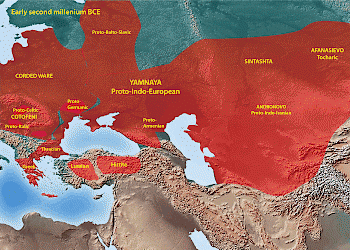
Towards the end of the third millennium BCE, when the Yamnaya and Corded Ware cultures had already been replaced by their successors, groups started to move to east. Archaeologists call them the Sintashta culture and - in a later phase - the Andronovo culture; linguists call them the Indo-Iranians. They may have called themselves "Aryans", a word that is known from early Persian (arya-) and Indian (árya-) sources.
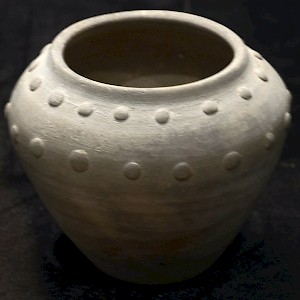
In what is now Uzbekistan, this group appears to have split up, one of them ending up in the Punjab and the other in Iran. The movement of this second group is documented in the spread of a simple kind of grey ceramics that can be seen in every museum in Iran. Perhaps, the division was caused by a religious dispute, because the words for "demon" and "deity" are linguistically related but theologically opposite (Indian: asura and deva; Persian: daiva and ahura).
Indo-European DNA
At the beginning of the twenty-first century, scholars were beginning to become increasingly convinced of the Kurgan hypothesis described above. It was confirmed in 2015, when two research groups independently discovered that Indo-European men shared a Y-DNA haplogroup that is called R1a. This is found in western Europe, in Ukraine, southern Russia, Uzbekistan, Iran, and among the priestly caste on the Indian subcontinent. A related haplogroup, R1b, is more specific for western Indo-Europeans.
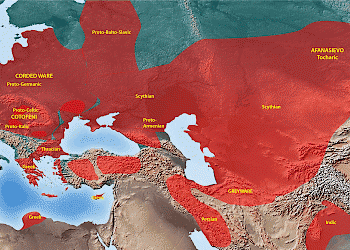
Another discovery was that the Indo-Europeans shared a genetic modification that allowed them to drink milk of non-humans (e.g., goat's and cow's milk). Lactase persistence gave the dairy pastoralists access to an additional source of food and may offer a partial explanation of their success. A success, however, that was also achieved by violence and murder: while in western Europe there is continuity in the mitochondrial DNA that people inherit from their mothers, a typically male Y-DNA group like G2a came to an end. The immigrants may have killed the original male population and we can imagine what the Indo-European men did to the female half the original population: in any case, they must have had children with the widows and daughters of the dead men.
Literature
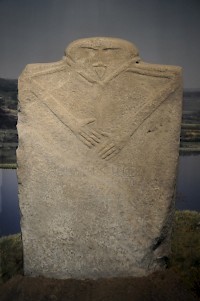
- J.P. Mallory, In Search of the Indo-Europeans (1989)
- B.W. Fortson, Indo-European Language and Culture (2010²)
- D.A. Anthony, The Horse, the Wheel, and Language (2007)
- J. Manco, Ancestral journeys. The peopling of Europe from the first venturers to the Vikings (2014²),
- E. Callaway, “Steppe Migration Rekindles Debate on Language Origin”, Nature, 18 February 2015.
- E. Callaway, “DNA Data Explosion Lights up the Bronze Age”, Nature, 10 June 2015

